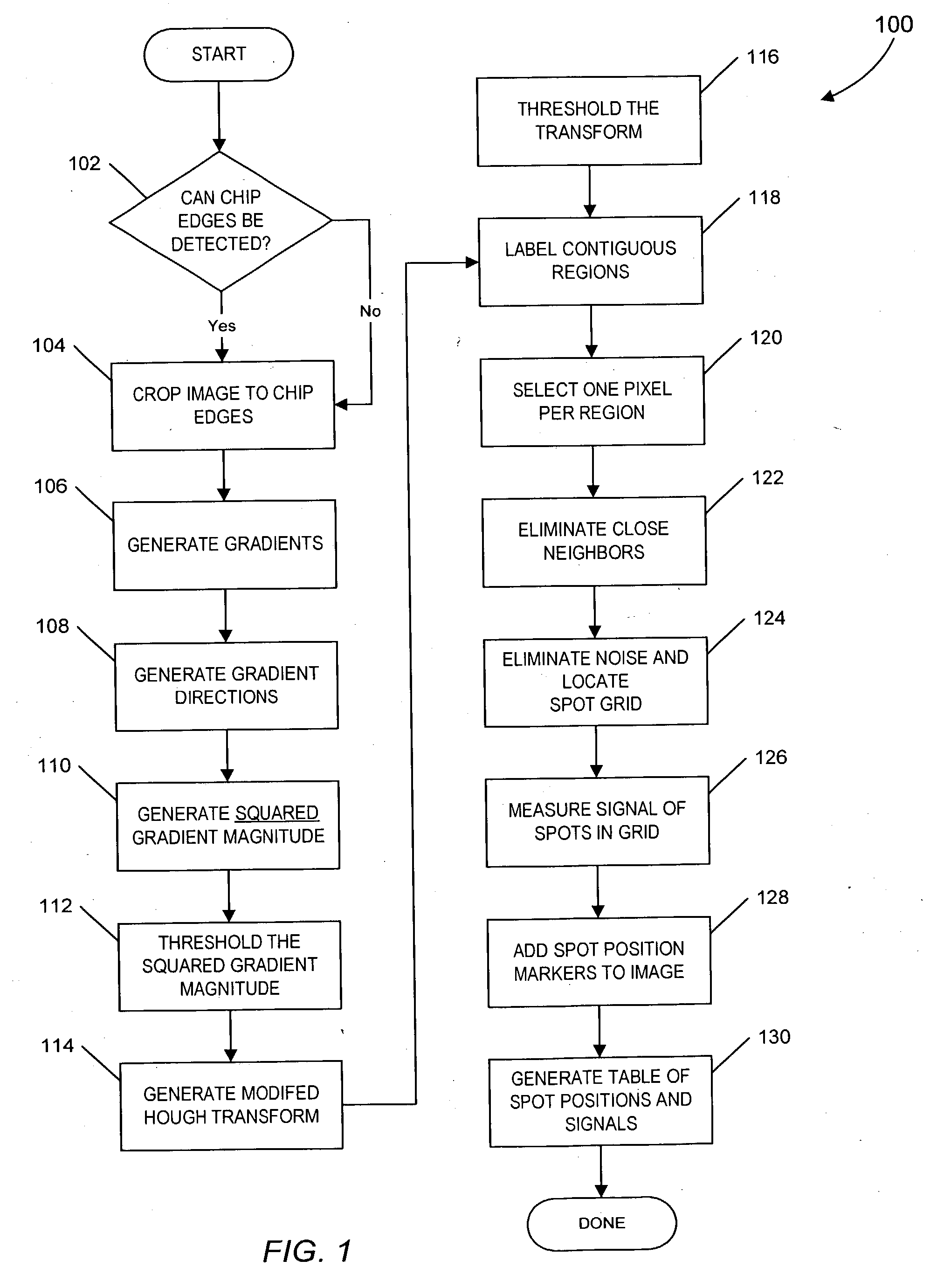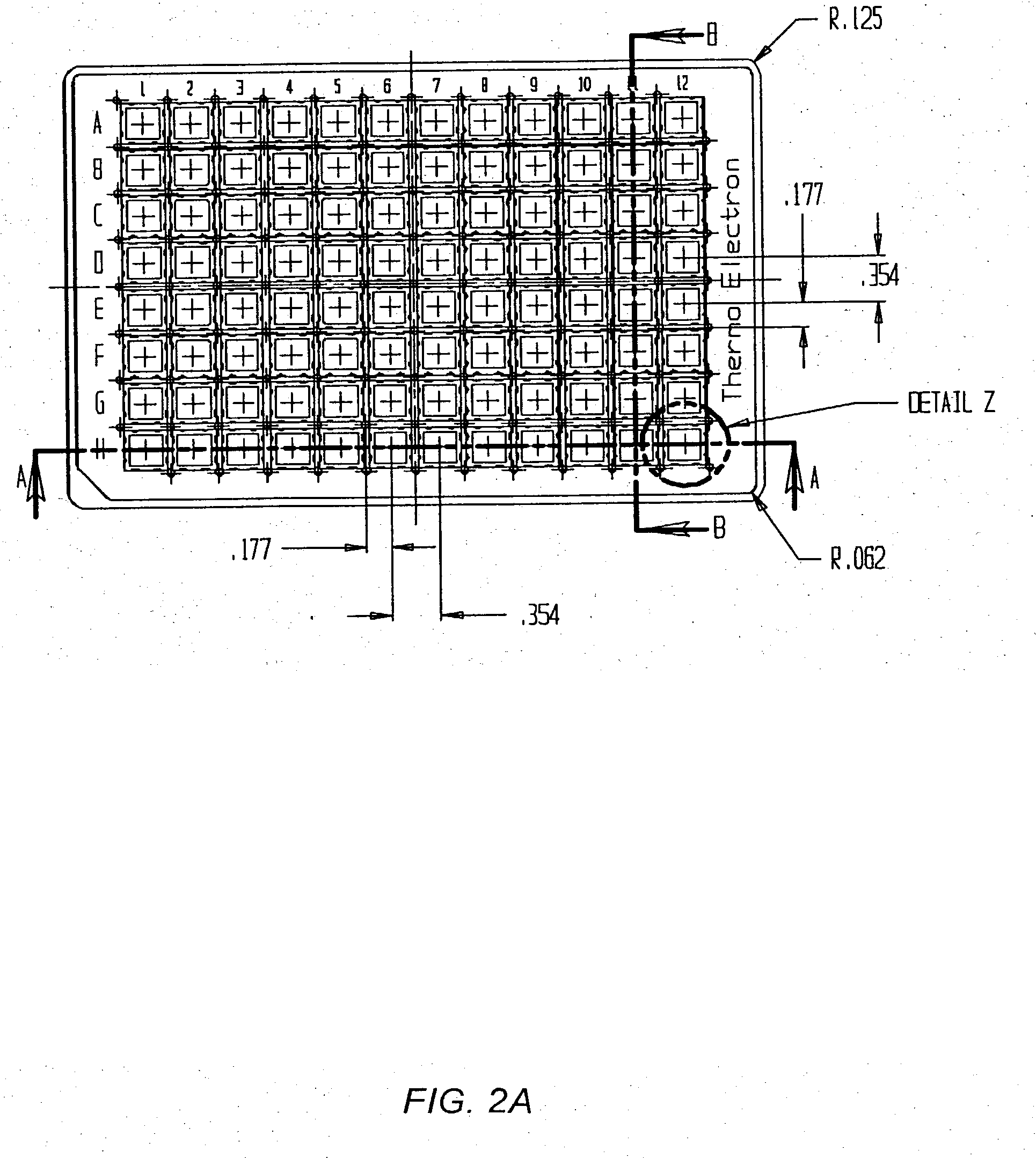Detection, resolution, and identification of arrayed elements
a technology of arrays and elements, applied in the field of arrays, can solve the problems of large amount of user interaction, large number of arrays, and inability to continue to capture photons, and software is not well suited to analysis of large arrays of elements, and even a limited number of elements
- Summary
- Abstract
- Description
- Claims
- Application Information
AI Technical Summary
Benefits of technology
Problems solved by technology
Method used
Image
Examples
example 1
[0167] Arrays designed to detect genomic target DNA sequences related to cystic fibrosis ("CF") from a sample following PCR amplification are described below. The test surface is an optical thin film surface that detects hybridization of target sequences to complementary immobilized capture sequences. The optical signal generated is a function of the change in optical thickness due to the hybridization event. The optical surfaces reflect incident white light such that specific wavelengths are attenuated or eliminated resulting in specific color changes. In the absence of a change in optical thickness, the reflected light maintains the original or background color.
[0168] Genomic sequences detected by the CF surfaces are specific to 25 mutations and polymorphisms within the CFTR gene and are shown in the following table:
1 2184del 2184del FM A WT A Mut 5T 7T 9T CC Neg .DELTA.F508 .DELTA.F508 I148T I148T .DELTA.I507 .DELTA.I507 G542x G542x WT Mut WT Mut WT Mut WT Mut G551D G551D W1282x ...
example 2
[0192] This study was designed to determine the performance tolerance of the image analysis station to tilt of a sample to be imaged in the x- and y-directions. A test surface with reacted and unreacted zones was placed on a goniometer that was placed in the optical field at the same depth of field, level of focus, and resolution that would be used in analyzing a test surface in a well of the 96 well plate. The goniometer allows very fine adjustments to the angle of tilt applied to the test surface. The test surface was evaluated with tilt applied to the x- and then the y-direction. Readings for a single reacted spot were taken at various angles of positive and negative tilt, as noted in the following table.
7 Contrast Tilt Angle (Positive-Negative) Total I -10 525 811 -5 843 1316 -4 914 1477 -3 920 1484 -2 992 1560 -1 990 1548 0 1014 1496 1 1027 1446 2 1028 1427 3 1007 1361 4 1021 1383 5 1001 1369 6 1008 1363 7 943 1247 8 887 1156 10 795 1058 Data is the same in the x -and y - direc...
example 3
[0194] To establish what if any impact ambient light may have on the measured signal intensity of reacted spots using the image analysis station, a plate containing multiple reacted surfaces was placed in the plate holder of the stage and aligned under the camera for imaging. Signal intensity of the various spots on the reacted test surface were measured in the presence and absence of ambient room light. Three reacted surfaces were measured at a polarizer setting of 45.degree. (midpoint) of dial range and a lamp position that is the dial mark just left of the top position and represents a moderate input intensity. Measurements were made at a number of sample positions on different test surfaces. The correlation of individual spot intensities for all spot positions in well C8 with and without room light is 93.7%. The correlation of individual spot intensities for all spot positions in well E8 with and without room light is 94.6%. Thus ambient light appears to have a minimal impact on...
PUM
 Login to View More
Login to View More Abstract
Description
Claims
Application Information
 Login to View More
Login to View More - R&D
- Intellectual Property
- Life Sciences
- Materials
- Tech Scout
- Unparalleled Data Quality
- Higher Quality Content
- 60% Fewer Hallucinations
Browse by: Latest US Patents, China's latest patents, Technical Efficacy Thesaurus, Application Domain, Technology Topic, Popular Technical Reports.
© 2025 PatSnap. All rights reserved.Legal|Privacy policy|Modern Slavery Act Transparency Statement|Sitemap|About US| Contact US: help@patsnap.com



